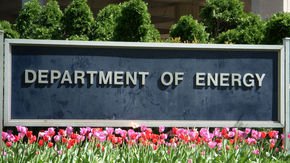Senators question nominees for DOE's science and clean-energy research wings

It’s summer in Washington, D.C., and the irony is in full flower. Yesterday, the Senate Committee on Energy and Natural Resources held a confirmation hearing for the White House’s nominees to head various parts of the Department of Energy (DOE) , including Christopher Fall, who would lead DOE’s $6.26 billion Office of Science, and Daniel Simmons, who would lead DOE's $2.32 billion applied research program in energy efficiency and renewable energy (EERE). Democratic committee members fretted that, ironically, Simmons had previously been a vice president at a think tank that called for eliminating EERE. Perhaps more ironically, EERE could cease to exist in a reorganization of the federal government proposed by the White House last week.
The committee also put questions to Teri Donaldson, the nominee to beDOE's inspector general, and Karen Evans, the nominee for the new position of DOE's assistant secretary of cybersecurity, energy security, and emergency response.
Fall, the nominee for director of the Office of Science, earned a doctorate in neuroscience but has spent the past 8 years in Washington, D.C., working in science policy, starting at the Office of Naval Research. During that time, he spent 3 years at the White House Office of Science and Technology Policy. He is currently acting head of DOE’s Advanced Research Projects Agency-Energy (ARPA-E), a $353 million agency whose goal is to help quickly translate ideas from DOE’s basic research into budding technologies. “ARPA-E might be the coolest job I've ever had,” Fall told the committee.
As director of the Office of Science, Fall would assume control of the United States’ single largest funder of the physical sciences. The office supports six research programs in advanced scientific computing, basic energy science, biological and environmental research, fusion energy research, high-energy particle physics, and nuclear physics. Fall told the committee that, if confirmed, his priorities would mirror those of Secretary of Energy Rick Perry. “Exascale computing, engineering biology, and artificial intelligence are all key new science priorities,” he said. “The nascent area of quantum information science presents a special opportunity for U.S. leadership.”
Simmons, a lawyer who is currently the acting head of EERE, faced questions from Democratic committee members about his commitment to developing new clean-energy technologies. Prior to joining DOE in 2017, Simmons worked at the Institute for Energy Research (IER) in Washington, D.C., where he questioned the federal government’s support of technologies such as wind energy and urged the government to speed up the permitting of fossil fuel exploration on federal property. In 2015, the IER’s advocacy arm, the American Energy Alliance, called for eliminating EERE to save money. “I'm trying to jibe your past career, which seems to me has been focused on working against renewable energy and climate science, with your role leading this agency,” said Senator Tina Smith (D–MN).
Smith noted that in 2013 Simmons wrote that “no matter what the renewable energy guys say, what they won’t admit is that their kind of energy, wind and solar, is more expensive and will increase the price of electricity.” She asked if Simmons thought that price should be the sole determining factor of what type of energy to use. Simmons responded that he did not. “The way I see my role here in the Office of Energy Efficiency and Renewable Energy is to reduce the cost to enable people to use those sources more often.” He noted that the price of solar power has come down substantially in the last 5 years. “That’s one of the things that’s changed since I made that statement.”
Smith also asked Simmons how he would reconcile the need to maintain the United States’ competitiveness in clean-energy technologies with the White House’s proposed 65% cut to the EERE budget in 2019, which begins 1 October. Simmons responded that by targeting early-stage research “we can do a lot of good at that level.” He also noted that the final say on the budget lies with Congress—which recently nixed a similar proposed cut to EERE for this year’s budget. “I wanted to make crystal clear that I understand that and that we work very hard to act on the budget that Congress has given us,” he said.
Senator Catherine Cortez Masto (D–NV) noted that last week the White House proposed a massive overhaul of the federal government that would roll EERE together with DOE’s applied energy programs in fossil energy, nuclear energy, and electricity. “It sounds like your position might be eliminated or folded into other offices,” she said. “How does this proposal affect your job to support and propel the implementation of the EERE technologies?” Simmons replied that he didn't know if the reorganization would eliminate his job. “I don't see this report as eliminating the support for renewable energy and energy efficiency,” he said. “What I think this reorganization is trying to do is have better coordination across the department.”
Senator Lisa Murkowski (R–AK), the chair of the committee, thanked Simmons for his candor on the implications of the proposed governmental reorganization. “Mr. Simmons, I think your answer is very honest, that ‘I don’t know yet,’” she said. “We don't know yet, either, and we’d like to get a little more information.” The committee would likely hold hearings on the reorganization, she said. Murkowski also warned the DOE nominees that their confirmation by the full Senate could take some time. “I think that we know that the dynamics on the floor are not particularly favorable for moving nominations forward,” she said, “but know that I intend to move your nominations as quickly as possible.”
